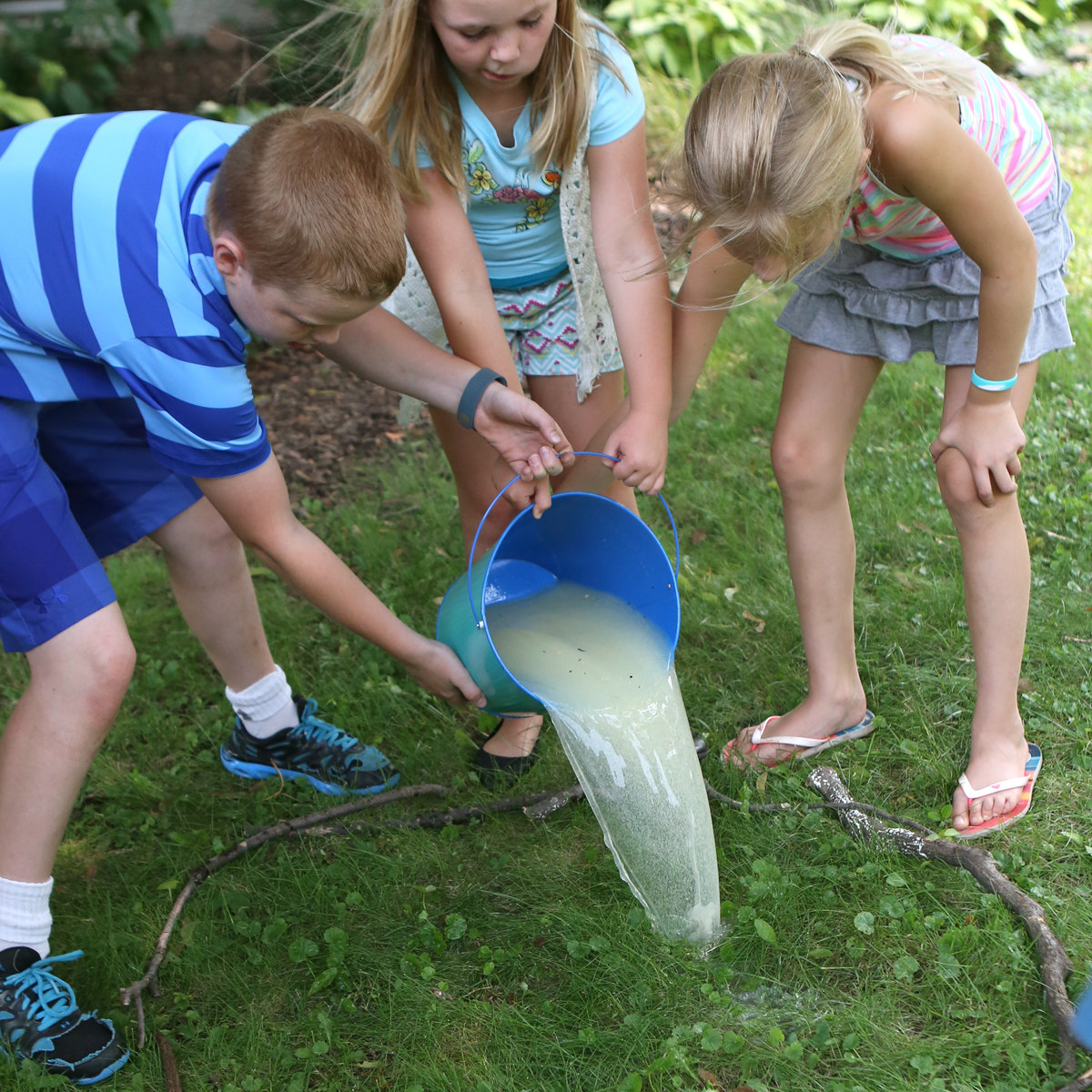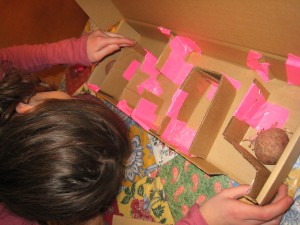Tag: experiments’
Dinosaur Science
- by KitchenPantryScientist
Today on Twin Cities Live, we did some dinosaur-related science experiments in honor of the Science Museum of Minnesota’s new Ultimate Dinosaurs exhibit.
Here are directions for doing the experiments in the video. Just click on the name to go to the post.
Window Stickies diffusion experiment
Have fun!
Kitchen Science
- by KitchenPantryScientist
“Are you a good cook?” was the first thing Dr. Tsneo Suzuki asked when I sat down in the office next to his cancer research lab at the University of Kansas. I stared at the picture of his wife, who I later learned had passed away from breast cancer, and wondered whether I should be offended.
After all, I was in my twenties and had five years of molecular biology experience under my belt. But I understood why he asked the question. Once you figure out how to test a hypothesis, most science experiments involve following recipes, which scientists call protocols. Generally, if you can read directions and mix things together in the correct order, in the right proportions, you can do things like amplify DNA and clone genes into bacteria.
So I truthfully answered “Yes, I’m a pretty good cook,” and got the job.

Food preparation is like a science experiment. If you can follow a recipe, you should get something close to what you set out to make, because often the ingredients will interact with each other to make something new. This is the very definition of a chemical reaction. Everything you cook with, from water to baking soda, is just a collection of molecules.
Here’s a collection of some food science experiments on my website. Since I love to cook, I hope to add more in the future! Leave a comment if you have other favorite kitchen science experiments, and I’ll try to add them to the list.
Testing Foods for Starch– Add a drop of iodine and watch for color change to detect starch.
Crock Pot Microbiology: Making yogurt from scratch is a delicious experiment
Yeast Experiment: Pyramids, Pasteur and Plastic Baggies– Grow yeast in a plastic bag to see how they make bread rise.
Emulsions: Mayonnaise and Vinaigrette– Mix the un-mixable using surfactants.
Curds and Whey: Make glue and plastic from milk and vinegar.
Gluten Ball– Explore the protein that makes bread chewy.
Red Cabbage Juice CO2 experiment– Use the pH-sensitive pigment in red cabbage to illustrate how CO2 can acidify liquids (and why soda is bad for your teeth.)
Homemade Petri Plates: test surfaces around your kitchen and house for microbes. Use to test fingers before washing, after washing with water alone, after washing with soap, and after using hand sanitizer.
So remember, cooking can make you a better scientist, and doing science can make you a better cook.
Earthworm Experiment: Alien Invaders!
- by KitchenPantryScientist

Earthworm Eruption from Outdoor Science Lab for Kids (Quarry Books 2018)
If you’re interested in studying the worms in your back yard, you can bring them to the surface using ground mustard seed dissolved in water.

Earthworm Eruption from Outdoor Science Lab for Kids (Quarry Books 2018)
Measure out a one square foot sample plot (35cmx35cm) with string and stakes, and pour about half of a your mustard mixture (1/3 cup ground mustard dissolved in 4 Liters of water) over the dirt in your grid. Be careful not to splash any in your eyes! Wait for the worms to come up, and when they’ve emerged completely, grab them and put them in a container. When they stop popping up, add the rest of the mustard mixture to the plot and wait for a second batch of worms to appear from deeper in the soil.

Earthworm Eruption from Outdoor Science Lab for Kids (Quarry Books 2018)
How many worms did you find? The Great Lakes Worm Watch is doing a study of worms, so you can preserve the worms and send them to their labs for identification, or you can try to identify them yourself. Great Lakes Worm Watch has other resources if you’re interested in learning more about Earthworms!

Earthworm Eruption from Outdoor Science Lab for Kids (Quarry Books 2018)
One of our favorite stops at the Minnesota State Fair is the Department of Natural Resources (DNR) building. After checking out some birds of prey, the fish pond and some monarch caterpillars, we stumbled on an entire room devoted to educating the public on the control of invasive species. Although I was familiar with buckthorn and Zebra Mussels, it was surprising to see the lowly earthworm represented alongside other more obvious dangers to Minnesota’s ecosystems.
We learned that the earthworms in Minnesota and the entire Great Lakes Region are non-native species, brought over from Europe long ago. They’re beneficial to farmers and gardeners, aerating the soil so water and other organic material can move through, but harmful to woodlands, where they disrupt the “Duff” layer of decomposing material on the forest floor, making it difficult for young plant to take root and grow. The lack of undergrowth affects the animal life as well, as hiding places and nesting grounds disappear.
If you like to fish or do worm composting, you can help! It’s very important never to discard unused worms in forests or even water (worms don’t drown.) Just throw them away in the garbage. Some worm mixes contain Asian earthworms of the genus Amynthas, which have become a threat in Minnesota. These worms are also called Jumping Worms since they are very active and lots of them can live together in one place causing lots of damage to forests.
Backyard Physics- Throwing Eggs
- by KitchenPantryScientist
It’s getting nice outside. Time to start thinking about backyard science! Here’s one of our favorites, if you haven’t already tried it! W

“Kids aren’t getting dirty these days. They’re not playing in the mud, not playing in rain puddles,” says Dr. Truglio, of Sesame Workshop in a Wall Street Journal article, about getting your kids outside.
Next to the kitchen table, my back yard (or front yard) is my favorite science laboratory. It has the added bonus of being easy to clean up. For this fun, messy experiment, a hose and a few paper towels do the trick. Make your kids clean up whatever mess they make!
My dad, who is a physicist, told me about this great demonstration. It teaches kids a little bit about motion and force while letting them do something that they are rarely, if ever, allowed to do- throw eggs! All you need is a sheet, some clothespins or string, raw eggs, and some paper. (You could use newspaper or easel paper. It is just to make cleaning up easier.) I also used a portable table turned on its side as a wall, but you could just use a wall or the side of a garage and have your child hose it off when you are finished.
Hang the sheet up from a tree, if you have one. If you don’t have a tree, you could hang it from anything else, or have two tall children or adults hold it. Then have two kids hold the bottom of the sheet up, or tie it to chairs so it makes a J shape when you view it from the side. The idea is to keep the eggs from hitting the ground and breaking.

An object in motion wants to remain in motion. To stop an egg moving through the air, you have to apply force to the egg. In this case, the force will be applied by a hanging sheet, or a wall.
Throw a raw egg at the sheet as hard as you can. It won’t break because the sheet slows the movement of the egg as it comes to a stop. The law of motion says that the faster you change the speed of an object, the greater the force applied to the object will be. When you change the speed of the egg slowly, like the sheet does, it lessens the force applied to the egg and the egg remains intact.
Now, put some paper on a wall (or table like we did.) Throw an egg at the wall. You’ll see what happens when something stops fast. Once again, the law of motion rules. When you change the speed of the egg quickly, it stops with a lot of force. SPLAT. This is my kids’ favorite part.

This is why they put airbags in cars. If a car is moving and hits something, causing it to stop very quickly, the airbag act like the sheet, slowing the person in the car down SLOWLY and greatly reducing the amount of force they might hit the dashboard with.
Record your results in your science notebook, if you want to. Finally, be sure to wash your hands when you’re finished experimenting and cleaning up. Raw eggs can have bacteria called Salmonella living in them and on them. Have fun!
Potato Maze
- by KitchenPantryScientist
I almost always have a sprouting potato or two around my kitchen. I’ll buy a bag of spuds and only use part of it, leaving the rest to turn green and eventually end up in the compost.

Luckily, those orphan potatoes are perfect for a few science experiments. One teaches you a little bit about physics as you watch an object in motion (a drinking straw) remain in motion as you drive the flimsy plastic deep into a potato. The other, a potato maze, teaches you a little biology as you think about what a potato needs to grow.
We’d stabbed a straw into a potato before, but it worked shockingly well with the boiling potatoes we got from our farm share. The straws went all the way through! Click here to learn how to do the potato experiment yourself!
but it worked shockingly well with the boiling potatoes we got from our farm share. The straws went all the way through! Click here to learn how to do the potato experiment yourself!
To make a potato maze, all you need is a sprouted potato, duct tape,some cardboard and a shoe box (or any cardboard box with a lid.)  Cut out cardboard pieces the same depth as the box, tape them together, bend them and tape them inside of the box to create a maze.
Cut out cardboard pieces the same depth as the box, tape them together, bend them and tape them inside of the box to create a maze.
Try to keep the walls of the maze the same height as the box and be sure to cut an opening at the far end of the maze so that light can get in at one end.
Put a sprouted potato or two in the maze. Close the box and seal any light leaks (other than the opening) with tape. (See photo at top for an idea of how your maze should look, but they’ll all be different and there’s no “right” way to make your maze! Just make sure there’s a direct tunnel between your potato and the opening!)
Place the box somewhere where it will get plenty of bright sunlight pouring into the opening. Wait a few weeks and check your potatoes. (You can check them more often if you’re impatient, but they won’t grow any faster.)
What happens to the potatoes?
They should grow towards the light, since plants need light to grow. Using a process called photosynthesis, they can change sunlight, carbon dioxide, water and minerals into electrical and then chemical energy, which allows them to grow into food for other living things. In the process, they also give off oxygen, the gas that we breath.
How do you your potatoes grow without food and water?
There are nutrients and water stored in potatos that allow them to start growing for a while without soil and water.